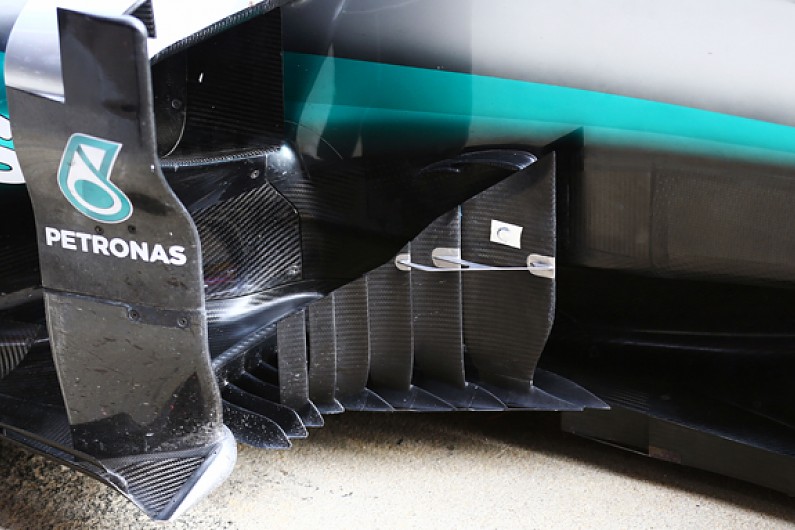Sky Sports, Nov 6, 2009 wrote:[...]
The OWG's solution was to cut aerodynamic grip for the 2009 season, with 50 per cent the reduction initially hoped for. (A figure of 90 per cent was first suggested but quickly shelved so as not to make Formula One cars slower than those in junior formulae.) To do this, the FIA mandated a lower, wider front wing with an adjustable element (in order for the driver to try and improve grip when moving to pass another car), as well as a smaller, higher rear wing (to lessen the trailing air disturbance). Appendages like bargeboards and chimneys, which have spread like a cancer in recent seasons, were also banned while rear diffusers were also made smaller to reduce their effectiveness. The 'push to pass' system afforded by KERS was billed as another plus, potentially helping a car exiting a corner to gain on a competitor on the following straight.
Factor in the return of slick tyres to boost mechanical grip and what resulted were, let's face it, a bunch of rather ungainly looking machines (BMW and Toyota surely being the worst culprits). But if they do the job to a noticeable degree then surely an awkward appearance would be a small price to pay?
Unfortunately, it appeared pretty much straight from the off that those wanting real change had been ripped off. A stern test came in May's Spanish Grand Prix, held on a circuit - Barcelona's Circuit de Catalunya - where there were two whole overtaking manoeuvres during the 2008 race. Fast forward 12 months and there were...four. Of course, you could argue that represents a 100 per cent improvement but for quite a few of us it still represented a good hour-and-a-half of our lives spent watching not very much.
So why has the improvement been, at best, only slight? The most obvious answer lies in the ability of Formula One engineers to take whatever rule changes the FIA throws their way and finagle a way around them. Such an example came at the start of the season when Brawn GP's interpretation of the new rules resulted in a "double decker" diffuser which offered them (as well as Williams and Toyota) a head start grip-wise and a kick-start to their successful World Championship bid. The reality is that such craftiness meant a downforce reduction of 50 per cent was always going to be unachievable - a reduction of between 15 and 25 per cent a more likely estimate for cars at the start of the season, with that figure eaten away still further as updates were introduced.
Then there's the tracks themselves. Speaking at July's German Grand Prix, one of Formula One's top finaglers, Red Bull designer Adrian Newey, said: "I think fundamentally the circuits are probably the biggest influence. Everybody seems to conveniently forget about that as it is deemed to be easier to change the cars than change the circuits." And yet the circuits have changed in recent years, with new purpose-built tracks in China, Bahrain, Turkey and now Abu Dhabi appearing alongside classics such as Monza, Silverstone and Spa. Much like the changes to the cars, though, the effect appears to have been imperceptible.
Rose-tinted
Speaking of perception, Newey also said the notion of a bygone age when "overtaking used to be fantastic", used by some to knock modern Formula One, was "rose-tinted". However, McLaren managing director Jonathan Neale points out the paradox which appears central to the problem: that overtaking has diminished as the field has grown more competitive. "People talk quite fondly and with dewy eyes about motor racing during the 1970s and even earlier and they forget that in those days the difference between first and second could be up to a second," Neale told skysports.com. "Some of the grid never qualified. So when you have cars that are that far apart, cars coming through from the back, mistakes being made...that produced a lot of overtaking. This year, front to back of the grid, on some occasions if you look at the race paces from recent races, it's probably only a second and a half. And when you've got that level of closeness between the cars it is more difficult, more challenging."
[...]
[John] Watson suggests a radical solution, albeit one he knows will never happen - the purist within him no doubt heaving a huge sigh of relief. In short, he thinks that Formula One can only guarantee more overtaking by following NASCAR's lead and effectively becoming a one-make formula. Much as NASCAR has used its 'Car Of Tomorrow' to provide a standard shell in which Ford, Chevrolet, Dodge and Toyota house their wares, he thinks the only real solution available is for the FIA to introduce a standard car including drive train, suspension, brakes, aero package and tyres that are "exceptionally hard by the standard of tyres they run today" - leaving teams to decide what engine to run.
He explains: "It's only by making draconian steps that you will get back longer braking zones and a lot less cornering power than we currently have. But that almost goes against what is Formula One. I would hate to see that actually because Formula One to me has always been about the ultimate in terms of whatever element it is: tyres, aerodynamics, chassis design, engines, whichever. But to the detriment it becomes a very...I have to say 'boring' is not correct but it isn't fulfilling the expectation."











